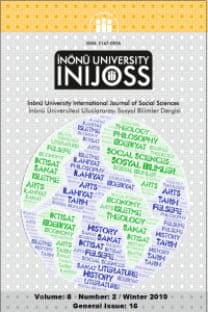ANTHONY BURGESS’S DYSTOPIAN VISION IN A CLOCKWORK ORANGE: FROM ULTRA-VIOLENCE AND DEHUMANIZATION OF MAN TO RELIANCE ON HUMAN GOODNESS
Öz
Anthony Burgess’s Clockwork Orange published in 1962 is both a dystopian novel
depicting a fictitious bad future in which the world is much more exposed to
ultra-violence and an anti-utopian text criticizing the government’s utopian
aspirations of eliminating extreme violence from the society by means of
behavioural sciences and demonstrating the fallacies of their strategy. This
paper argues that
Burgess’s novel is not a simple dystopia owing to the
dystopian elements in it; rather it has anti-utopian elements, which should be
distinguished from its dystopian elements. Moreover, Burgess blurs the
dystopian and anti-utopian vision in the novel through his retaining an abiding
faith in human goodness. In order to put forward these qualities of the novel,
the paper suggests dividing the novel into three parts. A Clockwork Orange was written in three parts of seven chapters but
this paper suggests dividing the book into two in relation to the dystopian
practice. The first section includes Part I and the second section includes the
whole of Part II and Part III excluding the seventh chapter. And this paper
will take the last chapter of the novel (i.e. the twenty-first chapter) as a
blur of the dystopian vision of the novel. The paper begins with a brief
introduction of utopia, dystopia and anti-utopia. Following this is a
discussion of the dystopian elements in the first part of the novel. The
ultra-violent acts of Alex and his gang of “droogs” are shown as the main
source of the dystopian world in the first part. Next the novel’s second
section is analyzed to put forward both its dystopian and anti-utopian
elements. In this part, it is argued that the utopian ideals of the government
turn into a dystopia for Alex, who is the cause of the dystopia in the first
part. This part also reveals that the novel involves anti-utopian elements,
through which Burgess shows the defects of the government’s tactics to turn the
criminals like Alex into individuals who do not commit crimes. In so doing
Burgess raises such ethical questions as whether the authority should discard
violence in return for its people’s free will and whether the sanctioned
violence makes people deprived of humanity. It can be claimed that Burgess
considers the scientists and the government depriving man of his capacity for
moral choice are, in effect, inferior to the criminals they attempt to treat.
The examination concludes with the idea that Burgess himself blurs the
dystopian vision of the novel with the twenty-first chapter yet it is the proof
of Burgess’s ending his novel with his reliance on human goodness.
Anahtar Kelimeler:
: A Clockwork Orange, Anthony Burgess, ultra-violence, sanctioned violence, deprivation of free will, human goodness
___
1. Abrams, M. H. (1999). A glossary of literary terms. USA: Heinle & Heinle.2. Abrams, M. H. & Harpham, G. G., (2009). A glossary of literary terms. Australia: Wadsworth.
3. Antick, J. R. & Rosqvit, j., (2002). Behavioural case formulation. Encyclopedia of Psychotherapy. (Ed. Michel Herser et.al.). (pp.185-190). USA: AP.
4. Burgess, Anthony. (1986). Introduction: A clockwork orange resucked. A clockwork orange. (pp.1-5)
5. Claey, G. & Sargent, L. T. (eds.), (1999). Introduction. The utopia reader. (pp. 1-5). New York: New York UP.
6. Davis Todd, F. & Womack, K. (2002). Oh my brothers: Reading the anti-ethics of the pseudo-family in Anthony Burgess’s A clockwork orange. College literature. 29 (2). pp. 19-36.
7. Estournel, N. (2013). The relevance of voice for understanding ethical concerns raised by Nabokov’s lolita and Burgess’s A clockwork orange. Opticon 1826. 15 (11). pp. 1-8.
8. Gordin, M. D., Tilley H., & Prakash G. (2010). Utopia/Dystopia: Conditions of historical possibility. Princeton: UP.
9. Höyng, P. (2011). Ambiguities of violence in Beethoven’s ninth through the eyes of Stanley Kubrik’s A clockwork orange. The german quarterly. 84 (2). pp. 159-176.
10. Kumar, K. (1993). The end of socialism? The end of utopia? The end of history? In K. Kumar & S. Bann (Ed.), Utopias and the millennium. (pp. 63-80). UK: Reaktion Books.
11. Lodge, D. (ed.). (1992). The art of fiction.USA: Penguin Books.
12. Mikics, D. (2007). A new handbook of literary terms. New Haven: Yale UP.
13. Rollyson, C. (ed.). (2001). Notable british novelists. I. California: Salem Press, Inc.
14. Sargent, L. T. (1994). The three faces of utopianism revisited. Utopian studies. 5(1). 1-37. USA: Penn State UP.
15. Vieira, F. (2010). The concept of utopia. In G. Claeys (Ed.), The cambridge companion to utopian literature. (pp. 3-27). Cambridge: Cambridge UP.
16. Wegner, P. E. (2002). Imaginary communities: Utopia, the nation and the spatial histories of modernity. Berkeley: University of California Press. ELECTRONIC SOURCES
17. Mc Leod, S. Behaviorist Approach (2013). Retrieved January 16, 2015 from
18. http://www.simplypsychology.org/behaviorism.html
19. Moya, S. “A Clockwork Orange: The Intersection between a Dystopia and Human Nature”. Retrieved January 20, 2015, from
20. http://epository.unm.edu/bitstream/handle/1928/16747/Moya%20Samantha%20A%20Clockwork %20Orhange.%20The%20Intersection%20Between%20a%20Dystopia%20and%20Human%20Na ture.pdf?sequence=1 .
21. Sargent, L. T. What is Utopia? Retrieved October 20, 2014 from http://www.oupjapan.co.jp/academic/vsi/readingguides/Utopianism_VSI_Reading_Guide.
22. Kumar, K. “Utopia and Anti-Utopia in the Twentieth Century”. Retrieved October 1, 2014, from http://cas.umkc.edu/econ/economics /faculty/Lee/courses/488/reading/utopia7.pdf.
- ISSN: 2147-0936
- Yayın Aralığı: Yılda 2 Sayı
- Yayıncı: İnönü Üniversitesi
Sayıdaki Diğer Makaleler
CLOUD NINE IN RELATION TO EPIC THEATRE
DISEMPOWERED ‘OTHERS’ AND THE FEMALE SOLIDARITY IN SUE TOWNSEND’S BAZAAR AND RUMMAGE (1982)
REFLECTIONS OF CULTURAL CONCEPTION OF SELF IN ZADIE SMITH’S THE AUTOGRAPH MAN
DUAL NATURE OF VIOLENCE AND DIVIDED SELF OF MAN IN THE POEMS OF TED HUGHES
A KOHUTIAN APPROACH TO “A BIT OF SINGING AND DANCING” BY SUSAN HILL
EDMUND BURKE: “REFLECTIONS ON THE REVOLUTION IN FRANCE”1
ECOLOGICAL CITIZENSHIP IN THE POEMS BY JOY HARJO
